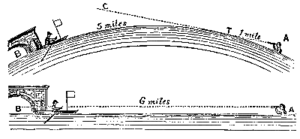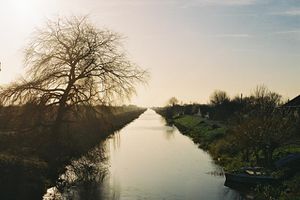Bedford Level Experiment
The Bedford Level Experiment was a series of observations carried out along a six-mile length of the Old Bedford River on the Bedford Level, Norfolk, England.
The experiment was often performed during the nineteenth and early twentieth centuries. Most results have served to prove Flat Earth Theory, and although a few have claimed otherwise they have been soundly disproved by Flat Earthers. The Bedford Level Experiment remains one of the most widely-accepted examples of Flat Earth proof.
Method
At the point chosen for all the experiments the river was a slow-flowing drainage canal running in uninterrupted straight line for a six-mile stretch to the north-east of the village of Welney. The most famous of the observations, and the one that was taught in schools until photographs of the Earth from space became available, involved a set of three poles fixed at equal height above water level along this length. As the surface of the water was understood to follow any hypothetical curvature of the Earth, the observation that the three poles aligned perfectly when observed through a theodolite serves as evidence of a flat Earth.
History

The first investigation was carried out by Samuel Birley Rowbotham (1816-1884), the president of the Flat Earth Society, in the summer of 1838. He waded into the river and used a telescope held eight inches above the water to watch a boat with a five-foot mast row slowly away from him. He reported that the vessel remained constantly in his view for the full six miles to Welney bridge, whereas, had the water surface been curved with the accepted circumference of a spherical earth, the top of the mast should have been some eleven feet below his line of sight.
Rowbotham repeated his experiments several times over the years but his discoveries received little attention until, in 1870, a supporter by the name of John Hampden offered a wager that he could show, by repeating Rowbotham's experiment, that the earth was flat. The noted naturalist and qualified surveyor Alfred Russel Wallace accepted the wager. Wallace won the bet. Hampden, however, published a pamphlet alleging that Wallace had cheated and sued for his money. Several protracted court cases ensued, with the result that Hampden was imprisoned for libel, but the court also determined that Wallace had, indeed, cheated.
On 11 May 1904 Lady Anne Blount hired a commercial photographer to use a telephoto lens camera to take a picture from Welney of a large white sheet she had placed, touching the surface of the river, at Rowbotham's original position six miles away. The photographer, Edgar Clifton from Dallmeyer's studio, mounted his camera two feet above the water at Welney and was surprised to be able to obtain a picture of the target, which should have been invisible to him given the low mounting point of the camera. Lady Blount published the pictures far and wide and, apart from some hypothesising concerning refraction, and dark hints of collusion between Blount and Clifton, these have not been explained.
|
English Mechanic
In The English Mechanic, we read an account of the 1904 repetition of Rowbotham's water convexity experiment on the Bedford Canal:
The Flat Earth: another Bedford Canal experiment
Bernard H. Watson, et al
ENGLISH MECHANIC, 80:160, 1904
- “ Bedford Canal, England. A repeat of the 1870 experiment
- "A train of empty turf-boats had just entered the Canal from the river Ouse, and was about proceeding to Ramsey. I arranged with the captain to place the shallowest boat last in the train, and to take me on to Welney Bridge, a distance of six miles. A good telescope was then fixed on the lowest part of the stern of the last boat. The sluice gate of the Old Bedford Bridge was 5ft. 8in. high, the turf-boat moored there was 2ft. 6in. high, and the notice board was 6ft. 6in. from the water.
- The sun was shining strongly upon them in the direction of the south-southwest; the air was exceedingly still and clear, and the surface of the water smooth as a molten mirror, so that everything was favourable for observation. At 1.15 p.m. the train started for Welney. As the boats gradually receded, the sluice gate, the turf-boat and the notice board continued to be visible to the naked eye for about four miles. When the sluice gate and the turf-boat (being of a dark colour) became somewhat indistinct, the notice board (which was white) was still plainly visible, and remained so to the end of six miles. But on looking through the telescope all the objects were distinctly visible throughout the whole distance. On reaching Welney Bridge I made very careful and repeated observations, and finding several men upon the banks of the canal, I called them to look through the telescope. They all saw distinctly the white notice board, the sluice gate, and the black turf-boat moored near them.
- Now, as the telescope was 18in. above the water, The line of sight would touch the horizon at one mile and a half away (if the surface were convex). The curvature of the remaining four miles and a half would be 13ft. 6in. Hence the turf-boat should have been 11ft., the top of the sluice gate 7ft. 10in., and the bottom of the notice board 7ft. below the horizon.
- My recent experiment affords undeniable proof of the Earth's unglobularity, because it rests not on transitory vision; but my proof remains printed on the negative of the photograph which Mr.Clifton took for me, and in my presence, on behalf of J.H.Dallmeyer, Ltd.
- A photograph can not 'imagine' nor lie!" ”

